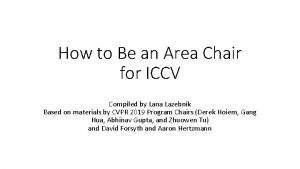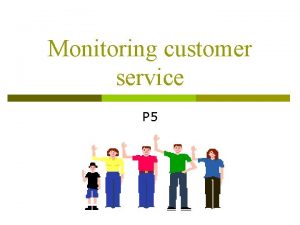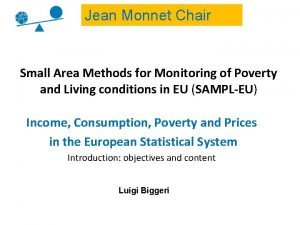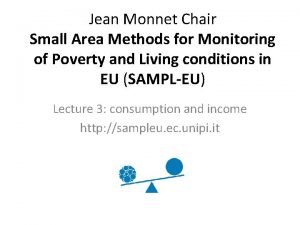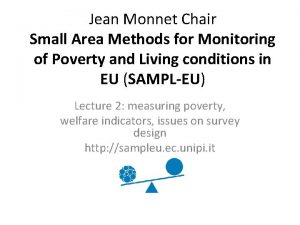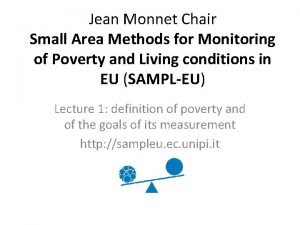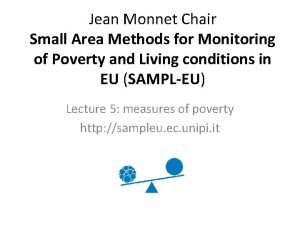Jean Monnet Chair Small Area Methods for Monitoring














- Slides: 14

Jean Monnet Chair Small Area Methods for Monitoring of Poverty and Living conditions in EU (SAMPL-EU) Lecture 6: Laeken Indicators http: //sampleu. ec. unipi. it

Laeken European Council • the Laeken European Council in December 2001 endorsed a first set of 18 common statistical indicators for social inclusion, which will allow monitoring in a comparable way of Member States’ progress towards the agreed EU objectives.

Four dimensions od social exclusion • These indicators need to be considered as a consistent whole reflecting a balanced representation of EU social concerns. • They cover four important dimensions of social inclusion (financial poverty, employment, health and education), • These highlight the “multidimensionality” of the phenomenon of social exclusion

Indicators • Indicator 1 a : At-risk-of-poverty rate by age and gender • Indicator 1 b : At-risk-of-poverty rate by most frequent activity and gender • Indicator 1 c : At-risk-of-poverty rate by household type • Indicator 1 d : At-risk-of-poverty rate by tenure status

Indicators • Indicator 1 e : At-risk-of-poverty threshold (illustrative values) • Indicator 2 : Inequality of income distribution S 80/S 20 quintile share ratio • Indicator 3 : At-persistent-risk-of-poverty rate by gender (60% median) • Indicator 4 : Relative at-risk-of-poverty gap

Indicators • Indicator 5 : Regional cohesion (dispersion of regional employment rates) • Indicator 6 : Long term unemployment rate • Indicator 7 : Persons living in jobless households • Indicator 8 : Early school leavers not in education or training

Indicators • Indicator 9 : Life expectancy at birth • Indicator 10 : Self defined health status by income level • Indicator 11 : Dispersion around the at-risk-ofpoverty threshold • Indicator 12 : At-risk-of-poverty rate anchored at a moment in time

Indicators • Indicator 14 : Inequality of income distribution Gini coefficient • Indicator 15 : At-persistent-risk-of-poverty rate by gender (50% median) • Indicator 16 : Long term unemployment share • Indicator 17 : Very long term unemployment rate • Indicator 18 : Persons with low educational attainment






 Jean monnet jean-gabriel monnet
Jean monnet jean-gabriel monnet Jean omer marie gabriel monnet
Jean omer marie gabriel monnet Jean monnet chair
Jean monnet chair Jean monnet chair
Jean monnet chair Ent aubigny-en-artois
Ent aubigny-en-artois Jean monnet les herbiers
Jean monnet les herbiers Jean monnet activities
Jean monnet activities Jean monnet activities
Jean monnet activities Jean monnet activities
Jean monnet activities Lum jean monnet
Lum jean monnet Cvpr borderline
Cvpr borderline Iccv duties
Iccv duties Pascale monnet chaloin
Pascale monnet chaloin Xavier monnet
Xavier monnet Monitoring customer service
Monitoring customer service











